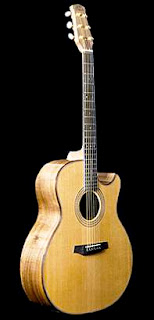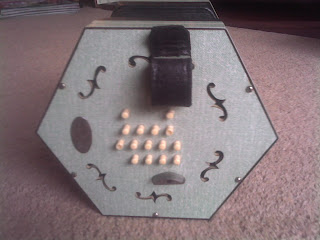When I asked for comments on the new site, Judi Derber emailed and requested a page about my instruments. Here it is!
I play mainly acoustic guitar and concertinas.
GUITARS etc:
I use a Fylde Magician, and have two identical models - one tuned as standard and one tuned to < D A D F# A D > an open D chord - sheer luxury!
 This came about when I started playing more and more songs in that tuning and didn't want to confront the audience with the hassle of endless retuning. I wanted to play songs in the order I decided, and not be swayed by whichever tuning the guitar was in. You can see the Magician and the rest of the range at
This came about when I started playing more and more songs in that tuning and didn't want to confront the audience with the hassle of endless retuning. I wanted to play songs in the order I decided, and not be swayed by whichever tuning the guitar was in. You can see the Magician and the rest of the range atfyldeguitars.com
At present I use Elixer Polyweb strings in Light gauge (12 to 53 thou). They're great if you've got sweaty fingers because they take a lot longer to go dull than conventional strings.
When it comes to amplifying through a PA system I don't like transducer pickups because the sound isn't natural. It's usually too bright and doesn't sound like an acoustic guitar - more like an electro/acoustic. So, I either use an external mic such as a Shure SM57 / 58, or the fitted lapel mic inside the guitar.
I've also got a Telecaster and an Ibanez Jazz guitar playing through a Fender Vibro Champ amplifier, but I use them for recording, not playing at concerts. Same applies to the mandolin, a Gremlin model, but I sometimes take my Framus banjo on bookings. Nice to have different colours for the accompaniment.
CONCERTINAS:
I've got a Wheatstone tenor #34120 made in 1936, and a Wheatstone contra-bass #29699 built in 1923, both with the English fingering system. There are also the Anglo and the Duet systems and all three are radically different, although to the casual observer they seem to look similar. The English system has the same note playing whether the bellows are moving in or out (as in the Duet system) and crosses from the left side to the right side to play consecutive notes in a scale (unlike the other two).
 The tenor 'tina has fewer notes at the top than the more common treble, but is extended below from C down to G. Coupled with a concertina's ability to play regardless of rhythm, this makes my box ideal for folk song accompaniment.
The tenor 'tina has fewer notes at the top than the more common treble, but is extended below from C down to G. Coupled with a concertina's ability to play regardless of rhythm, this makes my box ideal for folk song accompaniment.The bass concertina is unusual in that it has a one-way action. It plays notes as the bellows are closed together, but when they're pulled outwards then the instrument breathes (by using one-way pads underneath the bellows). Sounds odd, but I've played a two way action bass and didn't like it as much - I missed the rhythmic bounce of constantly filling the bellows.
An interesting Wheatstone I've got is the Mayfair. Looks odd with its formica sides, and it seems to have been an attempt in the 1950s to manufacture a low cost concertina.
 As well as the "kitchen unit" sides, the number of reeds was cut down to fifteen and arranged in three blocks of five per side. It didn't boost sales, though, and the company went under. It was resurrected in the 1970s when it was bought by Steve Dickinson, who still runs it.
As well as the "kitchen unit" sides, the number of reeds was cut down to fifteen and arranged in three blocks of five per side. It didn't boost sales, though, and the company went under. It was resurrected in the 1970s when it was bought by Steve Dickinson, who still runs it.

